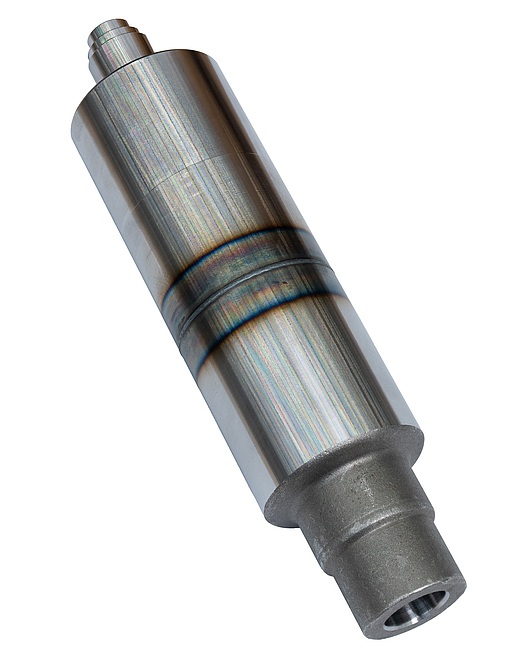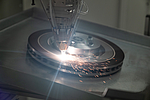06/20/2022 - Oliver Hagenlocher - Press
Laser Applications for Electromobility
There are various challenges in the field of electromobility or, to be exact, in industrial production for electromobility. The drive train must meet very high requirements in terms of precision, weight optimization, new environmental standards, etc. Laser technology offers perfect solutions for this. EMAG LaserTec shows how machinery manufacturers approach these tasks with a wide range of laser applications, which it has developed in recent years. From laser welding of highly complex drive components to laser cleaning of components to laser metal deposition for brake disks, EMAG shows the diversity of the machining operations that can be performed by or with laser beams.
Images
The importance of laser welding in car manufacturing has been increasing significantly for years, and not just in car body production. Many components “under the hood” – or, more accurately, in the drive train – benefit from the precise and fast process. Laser welding is likewise increasingly used in the manufacture of electric motors, for example with copper or aluminum compounds, especially in the electric drive and in the battery. Laser welding is also perfect for rotor shafts. When machining these “lightweight rotor shafts,” users benefit from the EMAG LaserTec specialists’ extensive experience with components. The company is a world leader in laser systems for the manufacture of powertrain components.
Mechanical engineering meets laser
High-precision and complex welds are only possible if the beam guidance system and the clamping of the workpiece are also highly precise. In other words, knowing how to clamp and machine a workpiece with the required control is essential for industrial production. These are typical topics faced in mechanical engineering, where not only the process itself, but also the complete infrastructure of the relevant user must be considered. How do the parts get to the machine, and in what condition? How is the machine loaded and unloaded? What is the downstream process? These are all aspects that influence the process reliability and must be taken into consideration. Consequently, modern production laser-welding systems like the EMAG ELC series, which fully satisfy the above requirements, have a lot more in common with machine tools than with typical welding systems.
Machines for laser cleaning
Producing flawless welds still requires proper preparation of the workpieces: High cleanliness requirements for the workpieces also apply when welding with a solid-state laser. Residues, like those from coolants, lead to faults like pores or cavities in the weld and need to be removed by reliable processes before welding. After many years in which washing the workpieces in a tunnel washer was standard practice, so-called laser cleaning now offers an alternative. The team at EMAG LaserTec recognized this early on, and for years has been relying on its own laser cleaning machines to enable the best possible welds. For the cleaning, an ablation process is used, in which brief but very powerful (> 10 kW) laser pulses are applied to the workpiece surface. Pulsed laser radiation is applied to a surface with high pulse peak power. The material instantly evaporates and only a very thin layer is heated in the process. Many types of impurities or coatings can be removed from a component pulse by pulse in this manner – from coolants or oils to oxide and graphite layers to rust, paint, and phosphate layers. The technology is also used to suitably prepare surfaces for subsequent work steps (e.g. “roughing”). In short, the process is extremely flexible and very energy efficient.
Laser metal deposition
EMAG LaserTec has developed two more new machines for laser applications. They can be used for coating brake disks, for example. Modern brake systems have always generated (too) many fine dust particles. Now there is a new challenge: The brakes on electric cars are used less frequently, since recuperation of the motor produces enough braking effect. When a brake disk is unused for long periods, it may even start to rust. The solution is coated brake disks, which are impervious to wear and corrosion. No fine dust is produced here – at least not by the disk. For the manufacture of such a brake disk, EMAG’s machine portfolio now includes the ELC 450 LMD and the ELC 500 DUO LMD for reliable laser metal deposition. With this method, a bond layer and the hard metal layer on top of it, for example, are applied to the brake disk by means of a laser welding process. Therefore, almost no material is lost.
A look at the details of the machine reveals exactly how this process works. The machines are equipped with either 1 or 2 (DUO) turntables. The component passes through the process two to four times, depending on the requirement for the coating system.
What are the requirements for laser metal deposition?
Process reliability is integral to industrial production. The operator must have the entire process under control. For laser metal deposition, in detail this means:
- Measuring the weight of the raw part
- Preparing for laser metal deposition: There are numerous ways of doing this, for example laser cleaning or preheating the components, etc.
- Laser metal deposition: Apart from the actual laser metal deposition, quality monitoring and control systems are extremely important. Examples:
- Monitoring and controlling the workpiece temperature
- Active coating thickness measurement
- Active weld pool monitoring
- Checking the powder stream caustic network
- Calibrating the powder delivery, etc.
The actual manufacturing process is much more complex than simply getting to grips with the technology. Mechanical engineering involves meeting the highest quality requirements, across thousands of parts, day in, day in. And consideration must also be given to the downstream steps. Not only to how the machined parts are transported onwards, but also to the process step that logically follows. In the case of the coated brake disk, the surface also needs to be ground. EMAG has developed a machine for this too, with the result that EMAG truly can offer the complete process chain from machining of castings to laser metal deposition to grinding.
This broad practical and technological knowledge allows EMAG, and in particular EMAG LaserTec‚ to offer customer-specific solutions based on standardized processes. At the same time, the company ensures cost-effective production processes in combination with the presented laser applications through perfect coordination of the mechanical engineering, the technology and the associated software. These are key USPs of EMAG LaserTec.
Contact

Oliver Hagenlocher
Area
Press and Communication















